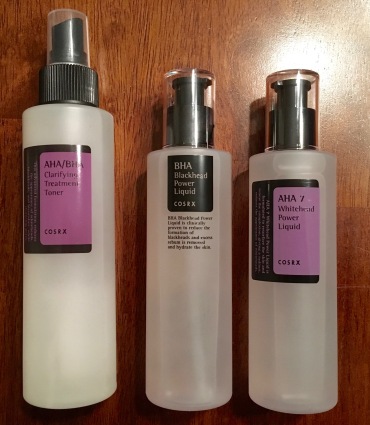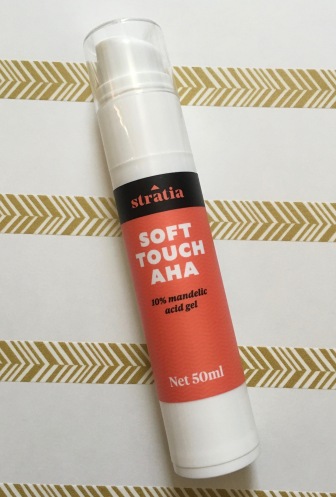This post was updated on 3/19/17 in order to reflect not only my current use of actives, but updated information based on the fact that I’ve learned more about them. As always, this is a learning process for me, so I’ll try to be as open and upfront as I can be when things change/I learn more. I’ve left the original post, crossed out things that aren’t accurate or are out of date, and added new information in bold/all caps.
I’ll be honest, because I do lots of reading and research before I try a product, I was scared to use chemical exfoliants, which are often referred to as “actives.” As you’ll see, there’s lots of chemistry talk, what with phs and acids, etc. I have a PhD in English lit: I’m much more comfortable analyzing a poem from an English metaphysical poet than I am learning about skin ph.
But I found, as with most things, that the more I learned, the more interesting the topic became. This is still true.
The chemical exfoliants I use are AHAs (alpha-hydroxy acids) and BHAs (beta-hydroxy acids).
[Note: Vitamin C, better called L-ascorbic acid (L-AA) and Vitamin A (retinoids such as retinol and tretinoin) are also actives, although L-AA isn’t technically an exfoliator. In any case, I will give Vitamin C its own post later on and won’t discuss it here, and I don’t use Vitamin A so I haven’t done much research on it. Exciting note: I’ve been researching some possible retinoids that are formulated so as not to be so irritating on the skin and will be purchasing one soon!]
These work to actually alter or change the skin over time rather that providing a temporary effect on the surface.
I will give you a basic run-down on AHAs and BHAs, as well as link to a bunch of further reading for you at the end of the post. Knowledge is power: you don’t want to make your skin worse by using powerful products without being informed!

AHAs and BHAs
AHAs are usually made from glycolic acid (some are made from lactic) can be made from glycolic acid, which is derived from sugar. It is the smallest molecule of any AHA and therefore can penetrate cells walls to get deep into your cells to work. It is extremely effective for this reason; it is also the most potentially irritating for this reason. AHA products can also be made with mandelic acid, which is derived from almonds. Mandelic acid molecules are larger than glycolic ones, and therefore can’t get as deep into your pores. While mandelic acid works is not quite as effective because it can’t get as deep into pores, it is also a lot less irritating. Other AHAs that work more on the surface of your skin include lactic acid (from sour milk), malic acid (from apples), and citric acid (from fruit). AHAs help aid in skin renewal. Basically, AHAs help dissolve the lipid bonds between skin cells, which aids in the removal of dead skin cells, speeding up the cell turnover process. This is why AHAs produce excellent, fast results such as increasingly smooth skin, fading of dark spots and hyper-pigmentation, and lessening of fine lines.
BHAs in skincare products are salicylic acid and helps to clean out pores. Because BHAs are oil-soluable, they are able to penetrate into your pores and clean out oils, dirt, and other potentially-clogging gunk. BHAs are anti-inflammatory and work to brighten skin.
Cons
These sound amazing, right? Well, there are cons, of course. AHAs cause photosensitivity when you use them, even up to a week after discontinuing use, which means you must. wear. sunscreen. (And finding a good sunscreen that doesn’t dry out your face and wears well under makeup if you wear CC or BB creams or foundation can be a pain.)
BHAs are drying. So, because I have drier skin, I up my hydrating products on days I use a BHA.
Both can cause purging. After you use a BHA or an AHA, they can cause whatever pores that were clogged and were going to become a pimple anyway–which can take about 8 weeks, believe it or not–to come to the surface faster because BHAs and AHAs speed up the rate of skin renewal, which means they speed up the process of pimple formation as well. This really isn’t a con, though, because after using them awhile, your pores clear up and the purging stops (and, hopefully, your number of pimples decreases as well).
Please note that only actives can cause purging in your skin. If this happens after any other product, it’s a breakout, not a purge. This means your skin is reacting poorly to the product, and you should stop using it. (This is why you only try one new product at a time.)
Some slightly less important downsides of BHAs and AHAs are that they often smell bad (although I don’t really notice any more) and when I first put my AHA on, my skin feels warm. It doesn’t burn, but there is a noticeable warming sensation. Now that I’ve switched from a glycolic acid product (the Cosrx AHA) to a mandelic acid product (Stratia’s Soft Touch AHA), I no longer have a warming or stinging sensation. My skin feels like I’m putting on any other product, which is how I know this was the right decision for my skin.

Note: you may recognize the Stratia brand from my favorite moisture-barrier building product, Stratia Liquid Gold. All of Stratia’s products are based on hard science, formulated by blogger Alli Reed, who runs the blog The Acid Queen. She cites her sources, explains her formulations, and I trust my face with her products. (Plus, I love supporting women-owned small businesses!)
Introducing an AHA or a BHA into your routine
First, please only use these if your skin needs them. My face has calmed down a lot since I began using Korean skincare, so I use them sparingly. If your skin doesn’t need them, don’t use them. These aren’t products to mess around with.
Introduce them slowly. I began using the Cosrx Blackhead Power Liquid (only 4% Betaine Salicylate, which is the milder form of BHA) once, at night, every three days. I did this for several weeks, then moved it to every other day. My skin has reacted well, and I may just keep it here unless I see an increase in clogged pores. Hahahaha. My skin is a fickle beast. After building up my moisture barrier for weeks and then slowly adding in the Stratia Soft Touch AHA and my skin reacting well, I used the Cosrx BHA. And my face freaked out. This wasn’t a purge–my skin broke out in itchy red bumps. I realized this may have been the root of my problems earlier and it will not touch my face again. My face cleared up a few days later and has been fine since. Apparently, some people can have sensitivities to BHAs.
Several weeks after I was sure my skin was ok with the BHA, I introduced the Cosrx AHA 7 Whitehead Power Liquid (a fairly mild AHA). Currently, I use it once a week, which I’ve been doing for several weeks, as well as using it as a spot-treatment for acne when needed. I might up this to twice a week if my skin flares up, but really, I don’t think I’ll need it much more than that. I doubt I will ever use AHAs and BHAs daily. I use my Stratia Soft Touch AHA about every 3-4 days. This has been my schedule for about a month now, and I’m happy with it. Absolutely not dryness and my skin is really soft and glowing. I may try to up it to every other day to see how my skin reacts, but I think twice a week is also fine based on the results I’m seeing.
Watch your skin closely. If you start to get peeling, lots of redness or dryness, or your skin begins to hurt when you’re using gentle, hydrating products, discontinue the use of your actives immediately. The last thing you want to do is to further damage your moisture barrier.
Step back from the acids for a week or so, hydrate your face to restore your moisture barrier, then reintroduce the acids slowly back into your routine. (It’s pieces of advice like this that scared me away from actives for awhile. The truth is, if you go slow and pay attention to your skin, you will be fine.)
SCIENCE! Or, how AHAs and BHAs Work
First, BHAs need a skin ph of about 3-4 in order to be effective. AHAs need a ph of about 4.5. As a result, if you’re using one or both, you will probably want to get a ph adjusting toner to bring down your skin’s ph more quickly. I use the Cosrx AHA/BHA Clarifying Treatment Toner immediately after I am done with cleansing.
Because BHAs generally work at a lower ph, put it on after the toner, which has lowered your skin’s ph. I then wait about 20-30 minutes for the BHA to do its work before moving on to my next product. (These wait times are all still good ideas, so I’m leaving them, but clearly this isn’t a part of my routine any more.)
On the days when my BHA and AHA “day” overlap, I still use my BHA first because it does the work of grabbing the dirt and oils out of my pores. So, the first part of my routine looks like this when I use both:
1st cleanse>2nd cleanse>ph adjusting toner>BHA (20 min. wait time)>AHA (2o min. wait time)
Why the wait time? Because it takes about 30 minutes for a product’s ph to neutralize, so if you add another product, which has a higher ph, before that time is up, it won’t be able to do all of its good work on your skin.
My new routine:
1st cleanse>2nd cleanse>ph adjusting toner>Stratia AHA (10-15 min. wait time)
Now, if you’re a careful reader, you may have spotted my Cosrx Natural BHA Skin-Returning A-Sol in my actives line up. So, how does it differ from the Blackhead Power Liquid? Well, I bought it not realizing that it’s a very mild BHA with such a low percentage of acid (it actually has about 60% propolis, which hydrates and soothes skin) and it works at such a high ph that it’s not really an exfoliant.
But it does help clean my skin, and it’s so mild that I use it every day, twice a day. If you have sensitive skin, you may want to start with the A-Sol. (Which is short for “acne solution,” btw.) This is still my favorite–I love it. It’s the only form of BHA I’ve found–as of now–that doesn’t irritate my skin! I’m still in the middle of researching BHAs and BHA sensitivity to see if there’s any I can use. But, if it seems as though my pores are ok without it, I’ll just forego using one.
Where does it go in my routine? In the morning it goes on right after cleansing, and at night it goes right after any other actives. I follow it up with my Missha FTE.
Further Reading/Citing My Sources
As a scholar and a teacher, it’s in my nature to cite my sources, as well as give homework. These links below work as both of those things: over the course of several months, I read other people’s writing on BHAs and AHAs, and over time all came together in my head. At this point, I’m not 100% sure which information came from where.
Still, I want to give the people I read regularly credit for giving me this information, and I want to give you a chance to read another perspective. So, if you’re interested, here is some further reading on chemical exfoliants.
Fiddy Snails: My go-to blogger who knows her stuff. She’s covered AHAs, BHAs, and actives in multiple blog posts: here, here, here, and here to give a few.
Snow White and the Asian Pear: Lots of in-depth stuff on product order here and good info on BHAs here.
Cosmetics info.org: A good basic rundown of AHAs


Great post, super informative!
LikeLike
Thank you! I hope it was helpful.
LikeLiked by 1 person
Thank you so much! I have a lot of clogged pores and just recently started AB, planning to introduce actives soon, your post helped me a lot. Very informative.
LikeLike
Thank you for posting this! I have a few BHA products in my cabinet and I wasn’t quite sure how they really work, I just use them and wait for results. Now I know it works and how it differs from AHA 🙂
LikeLike
I’m so glad it helped. Thanks for reading!
LikeLiked by 1 person
[…] or polyhydroxy acids, are a newish type of chemical exfoliant (see my post on chemical exfoliation here). PHAs do the same type of work as AHAs, but have much larger molecules, which means they […]
LikeLike
[…] irritating to my skin. After some extensive research (you can read my post on chemical exfoliants here), I realized my skin probably needed a different type of AHA, so I purchased the Stratia Soft Touch […]
LikeLike
I am trying to formulate a Koran skincare routine but I’m completely confused at every step! With regards to aha exfoliation – these often come as toners like ‘pixie glow’ – does this mean you can combine the toning and exfoliation step? And a lot of aha toners say they can be used every day – would you recommend this? Thank you x
LikeLike
Yes–all of the choice with an Korean skincare routine means it is easy to get confused. Just remember–there are no real “rules.” Just do what is best for your skin! There are exfoliating toners and hydrating toners. Pixie Glow and AHA toners are exfoliating and certainly can be used every day if your skin can take it (mine cannot). You can definitely follow up with a hydrating toner if you want! I use 3-4 different toners in one routine in the winter. They’re of varying thicknesses and my skin needs the moisture. Again, it all comes down to what your skin wants and needs.
LikeLike
Hi there. Should I skip the toning step if using an aha toner? And if the aha toner says it can be used on a daily basis – would you recommend this or should it only be used once or twice a week? Thank you!
LikeLike
If you use an AHA toner, you can still use a hydrating toner if you want. In terms of how often to use an AHA toner, it really depends on your skin. If your skin can handle it daily, then go for it! But I’d probably only use it in the evenings, and maybe start with every other day to see how your skin reacts.
LikeLike